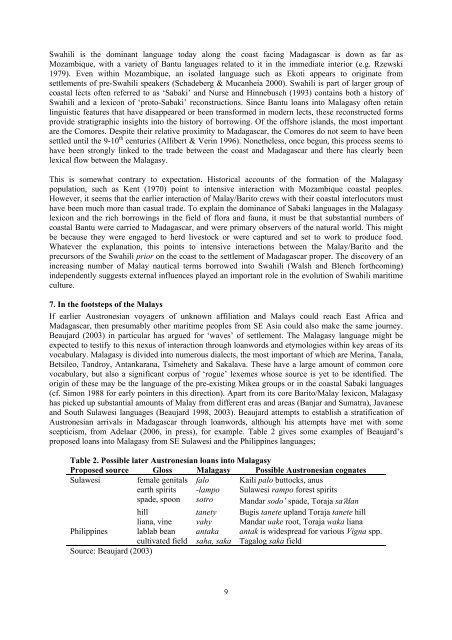Paper for Cambridge 2007 proceedings submit.pdf - Roger Blench
Paper for Cambridge 2007 proceedings submit.pdf - Roger Blench
Paper for Cambridge 2007 proceedings submit.pdf - Roger Blench
Create successful ePaper yourself
Turn your PDF publications into a flip-book with our unique Google optimized e-Paper software.
Swahili is the dominant language today along the coast facing Madagascar is down as far as<br />
Mozambique, with a variety of Bantu languages related to it in the immediate interior (e.g. Rzewski<br />
1979). Even within Mozambique, an isolated language such as Ekoti appears to originate from<br />
settlements of pre-Swahili speakers (Schadeberg & Mucanheia 2000). Swahili is part of larger group of<br />
coastal lects often referred to as ‘Sabaki’ and Nurse and Hinnebusch (1993) contains both a history of<br />
Swahili and a lexicon of ‘proto-Sabaki’ reconstructions. Since Bantu loans into Malagasy often retain<br />
linguistic features that have disappeared or been trans<strong>for</strong>med in modern lects, these reconstructed <strong>for</strong>ms<br />
provide stratigraphic insights into the history of borrowing. Of the offshore islands, the most important<br />
are the Comores. Despite their relative proximity to Madagascar, the Comores do not seem to have been<br />
settled until the 9-10 th centuries (Allibert & Verin 1996). Nonetheless, once begun, this process seems to<br />
have been strongly linked to the trade between the coast and Madagascar and there has clearly been<br />
lexical flow between the Malagasy.<br />
This is somewhat contrary to expectation. Historical accounts of the <strong>for</strong>mation of the Malagasy<br />
population, such as Kent (1970) point to intensive interaction with Mozambique coastal peoples.<br />
However, it seems that the earlier interaction of Malay/Barito crews with their coastal interlocutors must<br />
have been much more than casual trade. To explain the dominance of Sabaki languages in the Malagasy<br />
lexicon and the rich borrowings in the field of flora and fauna, it must be that substantial numbers of<br />
coastal Bantu were carried to Madagascar, and were primary observers of the natural world. This might<br />
be because they were engaged to herd livestock or were captured and set to work to produce food.<br />
Whatever the explanation, this points to intensive interactions between the Malay/Barito and the<br />
precursors of the Swahili prior on the coast to the settlement of Madagascar proper. The discovery of an<br />
increasing number of Malay nautical terms borrowed into Swahili (Walsh and <strong>Blench</strong> <strong>for</strong>thcoming)<br />
independently suggests external influences played an important role in the evolution of Swahili maritime<br />
culture.<br />
7. In the footsteps of the Malays<br />
If earlier Austronesian voyagers of unknown affiliation and Malays could reach East Africa and<br />
Madagascar, then presumably other maritime peoples from SE Asia could also make the same journey.<br />
Beaujard (2003) in particular has argued <strong>for</strong> ‘waves’ of settlement. The Malagasy language might be<br />
expected to testify to this nexus of interaction through loanwords and etymologies within key areas of its<br />
vocabulary. Malagasy is divided into numerous dialects, the most important of which are Merina, Tanala,<br />
Betsileo, Tandroy, Antankarana, Tsimehety and Sakalava. These have a large amount of common core<br />
vocabulary, but also a significant corpus of ‘rogue’ lexemes whose source is yet to be identified. The<br />
origin of these may be the language of the pre-existing Mikea groups or in the coastal Sabaki languages<br />
(cf. Simon 1988 <strong>for</strong> early pointers in this direction). Apart from its core Barito/Malay lexicon, Malagasy<br />
has picked up substantial amounts of Malay from different eras and areas (Banjar and Sumatra), Javanese<br />
and South Sulawesi languages (Beaujard 1998, 2003). Beaujard attempts to establish a stratification of<br />
Austronesian arrivals in Madagascar through loanwords, although his attempts have met with some<br />
scepticism, from Adelaar (2006, in press), <strong>for</strong> example. Table 2 gives some examples of Beaujard’s<br />
proposed loans into Malagasy from SE Sulawesi and the Philippines languages;<br />
Table 2. Possible later Austronesian loans into Malagasy<br />
Proposed source Gloss Malagasy Possible Austronesian cognates<br />
Sulawesi female genitals falo Kaili palo buttocks, anus<br />
earth spirits -lampo Sulawesi rampo <strong>for</strong>est spirits<br />
spade, spoon sotro Mandar sodo’ spade, Toraja saʔdan<br />
hill tanety Bugis tanete upland Toraja tanete hill<br />
liana, vine vahy Mandar uake root, Toraja waka liana<br />
Philippines lablab bean antaka antak is widespread <strong>for</strong> various Vigna spp.<br />
cultivated field saha, saka Tagalog saka field<br />
Source: Beaujard (2003)<br />
9

















